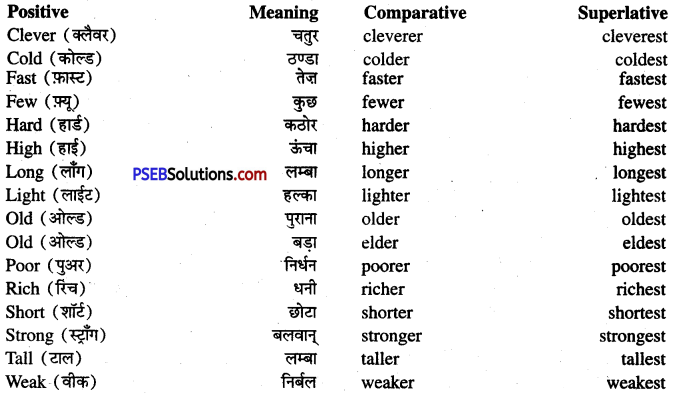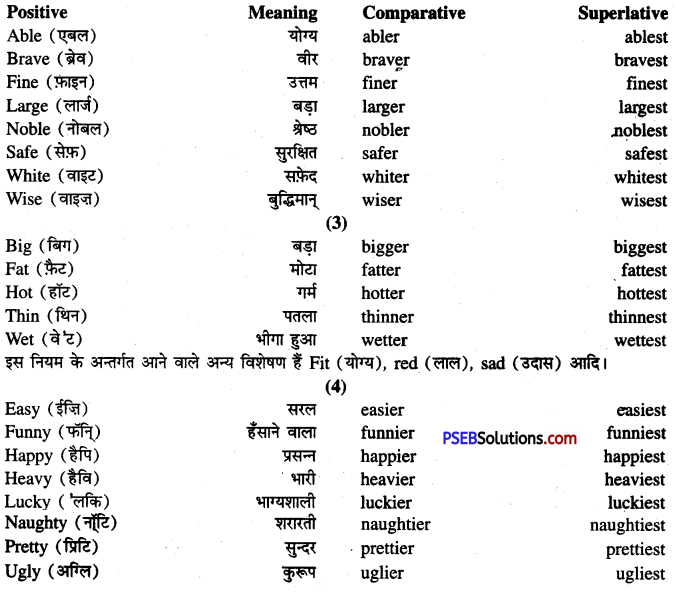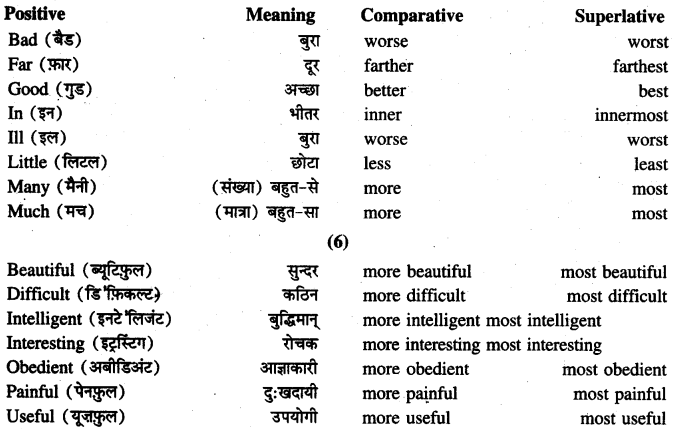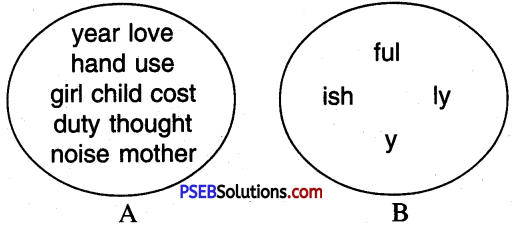Punjab State Board PSEB 7th Class English Book Solutions English Grammar Adjectives with Degrees Exercise Questions and Answers, Notes.
PSEB 7th Class English Grammar Adjectives with Degrees
An Adjective is a word which qualifies or adds something to the meanings of a Noun or a Pronoun.
जो शब्द किसी Noun अथवा Pronoun की विशेषता प्रकट करता है उसे Adjective (विशेषण) कहते हैं।
Adjective प्रायः Noun के साथ प्रयोग होता है और यह किसी व्यक्ति, पशु अथवा स्थान की विशेषता बताता है या किसी संख्या अथवा मात्रा का बोध कराता है। जैसे:
- Many years ago there was a miser. (संख्या)
- He never ate good food. (विशेषता)
- He spent little money. (मात्रा)
Adjectives मुख्यत: 9 प्रकार के होते हैं।
1. Adjectives of Quality. जो विशेषण किसी व्यक्ति अथवा वस्तु के गुण- दोष का बोध कराते हैं उन्हें Adjective of Quality (गुणवाचक विशेषण) कहते हैं। जैसे-
good, fresh, bad आदि।।
2. Proper Adjectives. Proper Nouns से बनने वाले विशेषण Proper Adjectives (व्यक्तिवाचक विशेषण) कहलाते हैं। जैसे:-
Indian, Chinese.
3. Adjectives of Quantity. जो विशेषण किसी वस्तु की मात्रा का बोध कराते हैं उन्हें Adjectives of Quantity (परिमाणवाचक विशेषण) कहते हैं। इस प्रकार के Adjective प्रायः कितने (How much) शब्द का उत्तर देते हैं। जैसे:-
some, no, great.
4. Adjectives of Number. जो विशेषण संख्या अथवा क्रम का- बोध कराते हैं उन्हें Adjectives of Number (संख्यावाचक विशेषण) कहते हैं। जैसे:-
two, all आदि।
5. Distributive Adjectives. जो विशेषण किसी विशेष वर्ग के व्यक्ति अथवा वस्तु को अलग-अलग प्रकट करें, उन्हें Distributive Adjectives (विभाजन विशेषण) कहते हैं। जैसे : each, either, every आदि।
6. Demonstrative Adjectives. जो विशेषण सम्बन्धित व्यक्ति अथवा वस्तु की ओर संकेत करते हैं उन्हें Demonstrative Adjectives (संकेतवाचक विशेषण) कहते हैं। जैसे:-
This pen; That girl.
7. Interrogative Adjectives. जो विशेषण प्रश्न पूछने के लिए प्रयोग किए जाते हैं उन्हें Interrogative Adjectives (प्रश्नवाचक विशेषण) कहते हैं। जैसे:-
which, what, whose आदि।
8. Possessive Adjectives. किसी वस्तु या व्यक्ति पर अधिकार व्यक्त करने वाले विशेषण को Possessive Adjectives (सम्बन्धवाचक विशेषण) कहा जाता है। जैसे:-
My book, Your brother, आदि।
9. Emphasizing Adjectives. जो शब्द Possessive Adjectives पर बल देने के लिए प्रयोग किए जाते हैं वे Emphasizing Adjectives कहलाते हैं।
प्रायः Own शब्द इसके लिए प्रयोग किया जाता है। जैसे:-
I became my own servant.
Degree of Adjectives
(1)

इसी प्रकार के कुछ अन्य विशेषण जिनके साथ er तथा est का प्रयोग होता है, निम्नलिखित हैं:
Loud (ऊंची आवाज़), small (छोटा), warm (गर्म), young (आयु में छोटा), cheap (सस्ता), bright (चमकीला) इत्यादि।
(2)

इसी प्रकार के अन्य विशेषण हैं, Busy.(व्यस्त), dirty (गन्दा), dry (शुष्क), early (पहले या जल्दी) इत्यादि।
(5)

इसी प्रकार के अन्य विशेषण हैं: Stupid (मूर्ख), active (फुर्तीला), expensive (महंगा), powerful (शक्तिशाली) आदि।
Exercise 1
I. Underline the adjectives of quality in the sentences given below. The first one has been done for you:
1. Reema is a good singer.
2. Naina wore a red sari for the party.
3. Johnny Walker was a funny man.
4. Look ! there’s a shiny coin.
5. Abha has chubby cheeks and a dimple chin.
6. Kolkata is a congested city.
7. Pandit Nehru was the first Prime Minister of India.
8. Get the black car from the garage.
9. Many families died in the earthquake.
10. Milk is a healthy drink.
Hints:
2. red
3. funny
4. shiny
5. chubby, dimple
6. congested
7. first
8. black
9. Many
10. healthy.
II. Add an adjective of quality to the following nouns. The first one has been done for you:
1. a tasty meal.
2. a ……….. bread.
3. a ………. dress
4. a ………. night
5. a ………. story
6. a ……… woman.
7. a ………. baby.
8. a ……… class.
9. an ………. play
10. a ……… building.
Hints:
2. fresh
3. new
4. dark
5. funny.
6. fat
7. lovely
8. middle
9. interesting
10. tall.
III. Replace the word in italics with a word from the box to give the opposite meaning and rewrite the sentence. The first one has been done for you:
tidy, short, broad, easy, sour, honest. active, modern, bright, strong, clever, useless.
1. It is a dull day. It is a bright day.
2. The room is untidy
3. The road ahead is narrow. …………..
4. Difficult sums take up time.
5. The sweet litchis are from Dehradun. ……
6. The weak boy won the match. ……………
7. The dishonest servant ran away. ……………
8. Jassi is very lazy. …………….
9. The fort is an example of ancient architecture…..
10. Babita is a foolish girl. ………….
11. The spanner is a useful tool. ………….
12. The tall boy is my brother. …………….
Hints:
2. tidy
3. broad
4. Easy
5. sour
6. strong
7. honest
8. active
9. modern
10. wise
11. useless
12. short.
IV. Choose from these adjectives of quantity and number to fill in the blanks given below. One has been done for you.
a few, ten, some, a little, second, enough, any, two, much, several, few.
(a) Some elephants were seen near a village.
(b) Renu has ……….milk every night.
(c) Sam has ……….money to buy a scooter.
(d) Rafiq found ……….gold coins in the trunk.
(e) The ……….day of the week is Monday.
(f). The ………. brothers live in Delhi.
(g) Very ……….tickets are there for the show.
(h) Put ……….sugar in the tea.
(i) Panna does not spend ……….time on exercise.
(j) I read ……….pages before going to bed.
(k) We have ……….fingers on our hands.
(l) ……… people watch the television everyday.
Hints:
(b) some
(c) enough
(d) several
(e) second
(f) two
(g) few
(h) a little
(i) any
(j) a few
(k) ten
(l) Several.
V. Fill in the blanks with an adjective of your choice:
(a) You will need ………… paper and ……….. ink for your test.
(b) ……… monkeys sat in the compartment.
(c) I have to write ………… letters today.
(d) Father sent ………….. money for my expenses.
(e) There are ………….. boys in the class.
(f) The book has …………. illustrations.
(g) I would like …………. tea.
(h) The ship sank into the ………. sea.
Hints:
(a) white, blue
(b) Some
(c) many
(d) enough
(e) thirty
(f) beautiful
(g) some
(h) deep.
Exercise 2
I. Fill in the blanks with the correct form of the adjective given in the brackets. The first one has been done for you:
1. Samarjit is the best showman in the town. (good)
2. Meena is the ……… girl in her class. (intelligent)
3. Anuj is ………. than Aman. (short)
4. Anita is ………. than Jamuna. (pretty)
5. Iron is the ………. of all metals. (heavy)
6. John is the ……… student in Mathematics. (bad)
7. Raman is ……. than Lalit. (tall)
8. A train journey is ……… than a road journey. (comfortable)
Hints:
2. most intelligent
3. shorter
4. prettier
5. heaviest
6. worst
7. taller
8. more comfortable.
II. Give the comparative and superlative degrees of the following adjectives:
| Positive |
Comparative |
Superlative |
| bright |
brighter |
brightest |
| noble |
nobler |
noblest |
| many |
more |
most |
| little |
less |
least |
| intelligent |
more intelligent |
most intelligent |
| strange |
stranger |
strangest |
| red |
redder |
reddest |
| bad |
worse |
worst |
| ugly |
uglier |
ugliest |
| Good |
better |
Best |
| rich |
richer |
richest |
| heavy |
heavier |
heaviest |
| wonderful |
more wonderful |
most wonderful |
| able |
abler |
ablest |
| much |
more |
most |
| clever |
cleverer |
cleverest |
| courageous |
more courageous |
most courageous |
| dirty |
dirtier |
dirtiest |
| neat |
neater |
neatest |
| wide |
wider |
widest. |
III. Use words from the box to complete the sentences. One has been done for you.
snow, ice, feather, lion, bee, snail, fox, silk, clown, bat.
1. Raj is as brave as a ………… .
2. Her friend proved to be as cunning as a ………… .
3. The room was as cold as …………… .
4. The pages were as white as ………… .
5. My sister is as busy as a …………. .
6. The old man is as blind as a ………….
7. Ramu is as funny as a …………. .
8. The train is as slow as a ……….. .
9. The box weighs as light as a …………. .
10. Her skin is as soft as ………… .
Answer:
1. Raj is as brave as a lion.
2. Her friend proved to be as cunning as a fox.
3. The room was as cold as ice.
4. The pages were as white as snow.
5. My sister is as busy as a bee.
6. The old man is as blind as a bat.
7. Ramu is as funny as a clown.
8. The train is as slow as a snail.
9. The box weighs as light as a feather.
10. Her skin is as soft as silk.
IV. Fill in the blanks with some, little, a little, few, much, any and many. The first one has been done for you:
1. I requested Salil to give me a ……….. money.
2. The trunk holds ……….. clothes.
3. There is ……….. space in the hall.
4. There were very …………. people at the party.
5. There are too ………. poor people in India.
6. I carried ……….. clothes for the trip.
7. Please pour ………. oil in the bottle.
8. Shiela has ………… work to do.
9. Raju has ………… friends in the U.S.A.
10. I take a ………….. food at night.
11. There aren’t ………… students in school today.
12. Rajat gave me ……… tips for the exams.
Answer:
1. I requested Salil to give me a little money.
2. The trunk holds some clothes.
3. There is little space in the hall.
4. There were very few people at the party.
5. There are too many poor people in India.
6. I carried some clothes for the trip.
7. Please pour some oil in the bottle.
8. Shiela has much work to do.
9. Raju has few friends in the U.S.A.
10. I take a little food at night.
11. There aren’t any students in school today.
12. Rajat gave me many tips for the exams.
V. Make sentence of your own with comparative and superlative of the adjectives of much, little, few and many. The first one has been done for you.
Answer:
1. More : I have more clothes than my sister.
Most : She is the most beautiful girl of our class.
2. Less : I spend less than I earn.
Least : I am least worried about his result.
3. Fewer : There are fewer boys than girls in the class.
Fewest : Attendance is the fewest today.
4. More : I have more clothes than my sister.
Most : Most of the students are absent today.
VI. Form adjectives by joining letters from circle ‘B’ with circle ‘A’ and make sentences of your own. One has been done for you.

1. yearly – They are holding yearly meeting.
2. lovely – She is a lovely girl.
3. handy – I have a handy bag.
4. useful – Milk is useful for health.
5. girlish – I don’t like your girlish behaviour.
6. childish – I don’t like your childish talks.
7. costly – The watch is very costly.
8. dutiful – Hira is a dutiful son.
9. thoughtful – He is in a thoughtful mood.
10. noisy – I cannot work in a noisy atmosphere.
11. motherly – She showers motherly love upon me.
VII. Pick out the adjectives in the following sentences and say whether they are adjectives of quality, quantity or number. The first one has been done for you:
1. Sonu is a dishonest man. (quality)
2. Dolly is six years old. (number)
3. There is little hope for her survival. (quantity)
4. There is very little milk to drink (quantity)
5. Those poor children are hungry. (quality)
6. How many marks have you got ? (number)
7. An empty mind is a devil’s workshop. (quality)
8. I have enough cash to buy a mobile. (quantity)
VIII. Underline the adjectives in the given sentences. The first one has been done for you:
1. A small leak can sink a big ship.
2. All work and no play makes Jack a dull boy.
3. He gave me many sweets.
4. These apples are raw.
5. The dog is a faithful animal.
6. Which book do you want to buy ?
7. There is a little milk in the jug.
8. A wise enemy is better than a foolish friend.
9. This is cold water.
10. He has enough milk for tea.
IX. Correct the degrees of adjectives in the sentences. The first one has been done for you:
1. He is the strong man in our village.
He is the strongest man in our village.
2. Ram gets less salary.
Ram gets a little salary.
3. Mohan is my older brother.
Mohan is my elder brother.
4. This mountain is high than that mountain.
This mountain is higher than that mountain.
5. My handwriting is better in the class.
My handwriting is the best in the class.
6. Gita’s left hand is weak than the right hand.
Gita’s left hand is weaker than the right hand.
7. Suman is good than Gurmeet in music.
Suman is better than Gurmeet in music.
Exercise 3
I. Underline demonstrative adjectives in the sentences. The first one has been done for you:
1. This sari is hand-painted.
2. Give me that book.
3. That book belongs to Milan.
4. These mangoes are for distribution.
5. These boys did not appear for the test.
6. Take that pot to the kitchen.
7. Ahmed joined this school recently.
8. Where did you get those flowers from?
9. Mohan presented me this silver plate.
10. We did not go to those places for security reasons.
Hints:
2. that
3. That
4. These
5. These
6. that
7. this
8. those
9. this
10. those.
II. Underline possessive adjectives and underline interrogative adjectives in these sentences:
1. What colour is your hair ?
2. Which is my towel ?
3. Whose car has her sister taken ?
4. What gift have you bought for your friend ?
5. Which desk is yours?
6. What is your name?
7. Whose watch has her brother worn ?
8. Which tools does the gardener need for his work ?
9. Which chocolates do you want for your shop ?
Hints:
1. What, your
2. Which, my
3. Whose, her
4. What, your
5. Which, yours
6. What, your
7. Whose, her
8. Which, his
9. Which, your.

![]()
![]()




